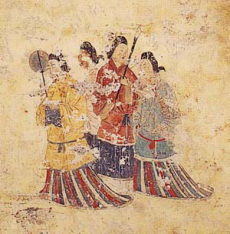Japanese culture

Japanese culture |
 |
Cultural heritages in Japan |
TOP > Japanese culture
Japanese Culture I would like to introduce you Japanese culture. in ths page. There is wide range of Japanese culture, so, first I will introduce 'National Treasures', 'Important Cultural Properties' and 'Intangible Cultural Heritages'. Then I will add some other types of cultures later. 1. National Treasures and Important Cultural Properties in Japan First of all, I will explain the definition of National Treasures and Important Cultural Properties. The Japanese Cultural Assets Preservation Act designates tangible and intangible cultural assets which are important from the historical and artistic points of view, and archeological assets and other scholary historical assets as 'Cultural Properties'. The law divides the assets into 6 categories as follows. 1. Tangible cultural properties. 2. Intangible cultural properties. 3. Folk cultural properties. 4. Memorials (historic sites, scenic beauty and natural treasures). 5. Cultural landscape. 6. Traditional constructions. Among 'Tangible cultural properties', the ones designated by the nation (Minister of Education, Culture, Sports, Science and Technology) are called 'Important Cultural Properties'. And the properties among 'Important Cultural Properties' which are especially highly produced and historically significant are designated as 'National Treasures'. The number of Important Cultural Properties is 12,655 (National Treasures is 1,076) at the end of 2008. National Treasures and Important Cultural Properties are divided into 'Cunstructions' and 'Arts and Crafts'. And 'Arts and Crafts' is divided into 7 categories as follows. Constructions Arts and Crafts Paintings Sculptures Crafts Calligraphy and books Ancient letters Archeological documents Historical documents 2. World Intangible Cultural Heritages 'Wolrd Intangible Cultural Heritages' is a list maintained by UNESCO with pieces of intangible culture considered relevant by that organization which was adopted in 2003. The first list was maid in 2008. Previous to the convention coming into force, 90 properties are released as 'The Masterpieces of the Oral and Intangible Heritage of Humanity'. From Japan, the following heritages are on the list. 2008 Nogaku Ningyo joruri bunraku Kabuki 2009 Gagaku (court music) Ojiya-chijimi & Echigo-johu (ramie fabric) Sekishu-banshi (paper making) Hitachi Furyumono (festival float) Kyoto Gion Festival (Yamahoko float ceremony) Toshidon of Koshikijima (Shinto ceremony) Aenokoto of Okunoto (rice paddy ceremony) Hayachine kagura (Shinto music and dance) Taue-odori of Akiu (rice planting dance) Chakkirako (New year dance) Dainichido bugaku (medieval dance) Daimokutate (story chanting and dancing) Koshikibuyo of Ainu (traditional dance) 2010 Kumiodori (Okinawa musical theater) Yuki-tsumugi (silk fabric) 2011 Hanataue of Mibu (rice planting ceremony) Sadashinno (nogaku of Sada Shrine) 2012 Nachi no Dengaku (religious performing art) 2013 Washoku (traditional Japanese cuisine) 2014 Washi (traditional Japanese handmade paper) 2016 Festival Floats (from 33 festivals all over Japan) 2018 Raiho-shin, ritual visits of deities in masks and costumes 2020 Traditional skills, techniques and knowledge for the conservation and transmission of wooden architecture in Japan 2022 Furyu-odori, ritual dances imbued with people's hopes and prayers 2024 Traditional Japanese Sake Making 3. Memories of the World The program began in 1992 by UNESCO as a way to preserve and promote documentary heritage, which can be a single document, a collection, a holding or an archival fonds that is deemed to be of such significance as to transcend the boundaries of time and culture. From Japan, the following heritages are on the list. 2011 Paintings of Chikuho Coal Mine by Sakubei Yamamoto 2013 Midokanpakuki: the original handwritten diary of Fujiwara no Michinaga Materials Related to the Keicho-era Mission to Europe 2015 Archives of Toji temple contained in one-hundred boxes Return to Maizuru Port: Documents Related to the Internment and Repatriation Experiences of Japanese (1945-1956) 2016 Three Cherished Stelae of Ancient Kozuke 2017 Documents on Joseon Tongsinsa/Chosen Tsushinshi: The History of Peace Building and Cultural Exchanges between Korea and Japan from the 17th to 19th Century 2023 The Monk Enchin Archives: A History of Japan-China Cultural Exchange |
 Wall painting at Takamatsuzuka Ancient Burial Mound (National Treasure) - Constructions - Paintings - Sculptures - Crafts - Calligraphy and Books - Ancient Letters - Archeological artifacts - Historical artifacts - Nogaku - Ningyo joruri bunraku - Kabuki |
| Copyright(C) Let's Travel in Japan! All Rights Reserved |
| 〔PR〕 forex trading systems, online forex trading, online forex |